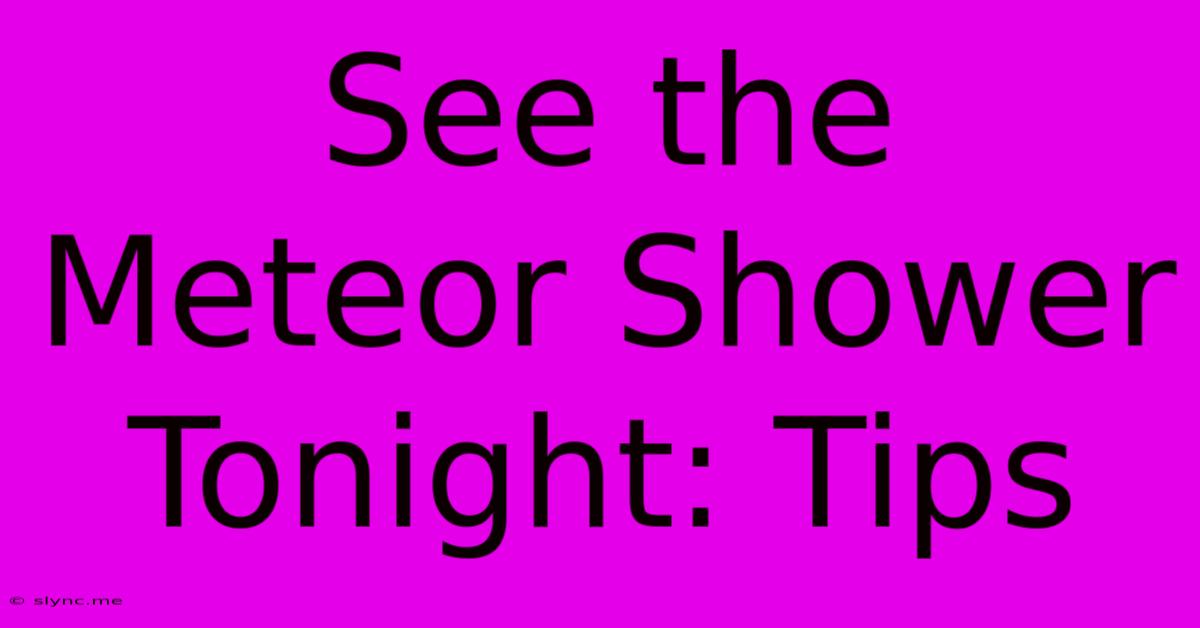See The Meteor Shower Tonight: Tips

Discover more detailed and exciting information on our website. Click the link below to start your adventure: Visit Best Website Mrs.Amykhan. Don't miss out!
Table of Contents
See the Meteor Shower Tonight: Tips for Amazing Stargazing
Are you ready for a celestial spectacle? Tonight's meteor shower promises to be a breathtaking display, and we've got the tips you need to make the most of it. Forget about light pollution and blurry photos; follow our guide for an unforgettable experience.
Finding the Perfect Viewing Spot
The key to a successful meteor shower viewing is location, location, location! Light pollution from cities dramatically reduces visibility. Escape the urban glow and head to a dark-sky location.
Tips for Finding Dark Skies:
- Check light pollution maps: Websites and apps dedicated to light pollution (like Light Pollution Map) can pinpoint areas with minimal light interference.
- Consider rural areas: National parks, forests, and remote areas are ideal. Check for accessibility and potential restrictions before you go.
- Get away from city lights: Even a short drive outside the city limits can make a significant difference.
- Elevate your viewpoint: Higher ground offers clearer views, reducing obstructions from trees and buildings.
Essential Gear for Meteor Shower Viewing
While you don't need a telescope for a meteor shower (they're best viewed with the naked eye!), a few items can enhance your experience:
- A comfortable blanket or camping chair: You'll likely be spending a while looking up, so comfort is key.
- Warm clothing: Even in summer, nights can get chilly. Layers are your friend!
- Red light flashlight: Regular flashlights can disrupt your night vision. A red light preserves your ability to see the meteors more clearly.
- Bug spray: Depending on your location and the time of year, insects can be a nuisance.
- Snacks and drinks: Pack some refreshments to keep you energized throughout the night.
Maximizing Your Meteor Shower Experience
Now that you're prepared, let's talk about making the most of the show:
Tips for Optimal Viewing:
- Arrive early: Give yourself time to adjust to the darkness and find a comfortable viewing position. Your eyes need about 20-30 minutes to fully adapt.
- Look beyond the radiant: While the radiant point (the point in the sky where the meteors appear to originate) is important for identifying the shower, the meteors will streak across a much wider area of the sky. Don't focus solely on one point.
- Be patient: Meteor showers are not constant displays. There will be lulls, so relax and enjoy the anticipation.
- Check the forecast: Cloud cover can completely ruin your view. Check the weather forecast before heading out.
- Share the experience: Invite friends or family along for a shared adventure under the stars.
Photographing the Meteor Shower
Capturing the beauty of a meteor shower can be challenging but rewarding.
Photography Tips:
- Use a tripod: Essential for long exposure shots.
- Wide-angle lens: A wider field of view increases your chances of capturing meteors.
- High ISO setting: This allows for better light sensitivity in low light conditions.
- Long exposure: Experiment with longer shutter speeds (several seconds to minutes) to capture faint meteors.
- Manual focus: Set your lens to infinity for sharp images.
With a little planning and these helpful tips, you're ready for a spectacular meteor shower viewing experience. So, get ready to gaze up and be amazed by the celestial wonders above! Remember to check your local astronomy websites or apps for precise timing and radiant location information specific to your area. Happy stargazing!

Thank you for visiting our website wich cover about See The Meteor Shower Tonight: Tips. We hope the information provided has been useful to you. Feel free to contact us if you have any questions or need further assistance. See you next time and dont miss to bookmark.
Also read the following articles
| Article Title | Date |
|---|---|
| Sms Brama Bezpechno Chi Ni | Dec 13, 2024 |
| Skladi Ta Onlayn Roma Braga Pryama Translyatsiya | Dec 13, 2024 |
| Friday The 13th Superstitions And Tattoo Meanings | Dec 13, 2024 |
| Ukrayina Ogolosheno Povitryanu Trivogu | Dec 13, 2024 |
| December 13th Friday The 13th Myths | Dec 13, 2024 |
